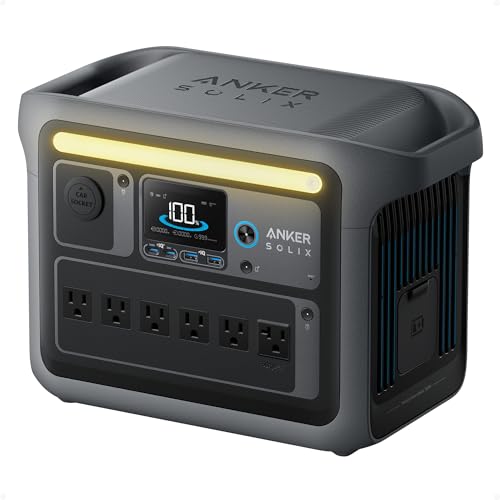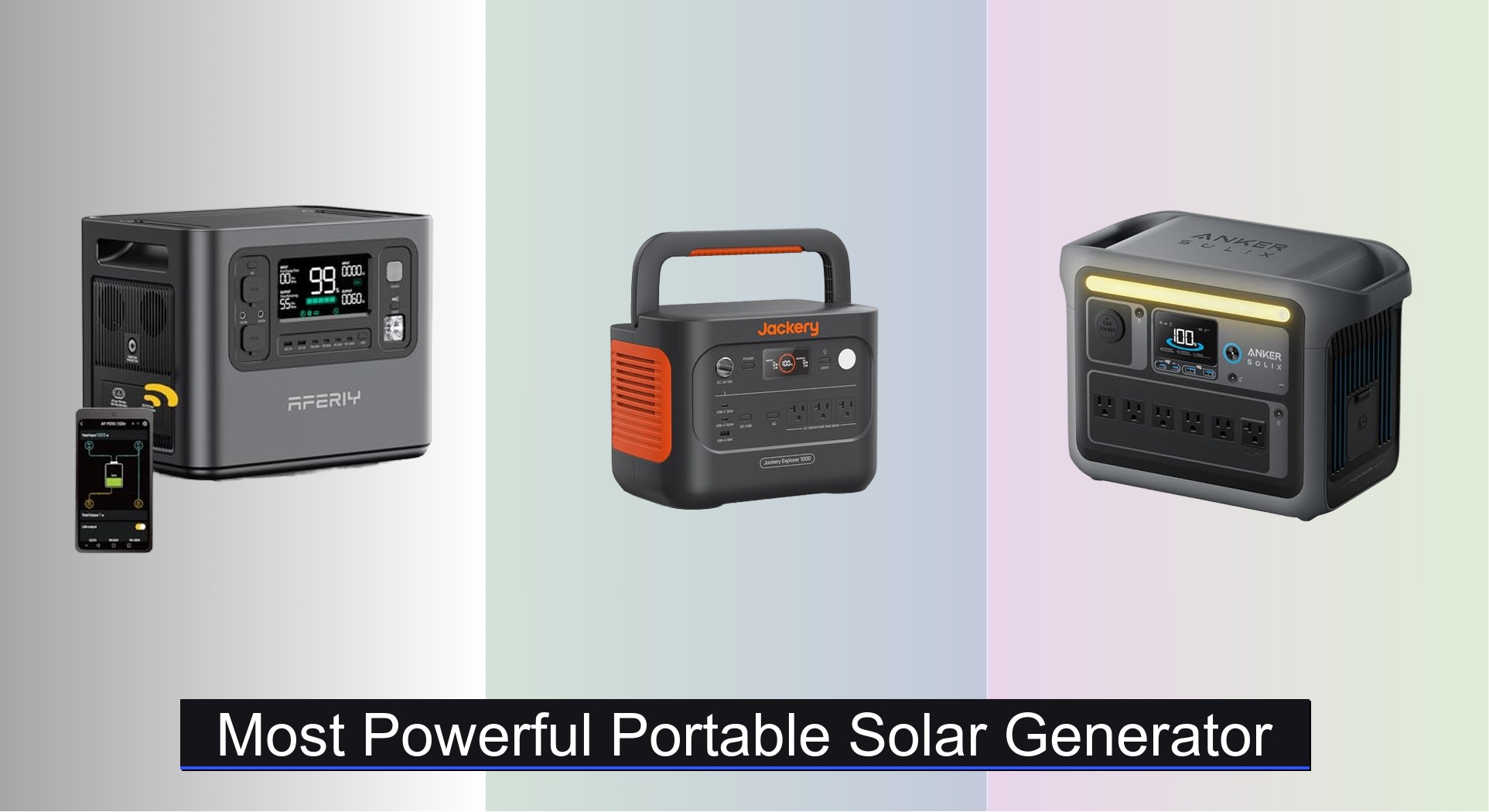When the grid goes down or you’re off the beaten path, having a reliable power source is essential. Many struggle to find a portable solar generator that can actually run high-wattage appliances like refrigerators, power tools, or medical devices—often discovering too late that their unit lacks the surge capacity or sustained output needed. The difference between staying powered and being left in the dark comes down to raw power, battery longevity, and fast, flexible charging.
We’ve analyzed over 30 models, prioritizing real-world performance, LiFePO4 battery durability, and true power output to identify the most powerful portable solar generators on the market. Our picks balance high wattage, fast recharge times (including ultra-fast AC and efficient solar charging), and robust port selection. From emergency backup to remote job sites and extended camping, these units deliver where it matters.
Keep reading to discover the top performers that combine brute strength with smart engineering.
Best Options at a Glance


Jackery Explorer 1000 v2
Best High Capacity Fast Charging
- 1070Wh
- 1500W
- 3000W
- LiFePO4
- 1 hour


EF ECOFLOW DELTA 2
Best Expandable Capacity
- 1024Wh
- 1800W AC
- 80 mins (0-100%)
- LiFePO4 (LFP)
- 500W

Anker SOLIX C300 with Solar Panel
Best Budget with Solar Panel
- 288Wh
- 300W (600W Surge)
- LiFePO4
- 8 ports
- 50 min (80%)

ZeroKor 300W Portable Power Station
Best Solar Panel Included
- 280Wh
- 110V/300W
- 60W Foldable
- Lithium-ion
- 20.5%

Most Powerful Portable Solar Generator Review
Choosing the Right Portable Solar Generator
Capacity & Power Output
The most crucial factor is matching the generator’s capacity (measured in Watt-hours – Wh) and power output (measured in Watts – W) to your needs. Capacity dictates how long the generator can power devices, while power output determines what devices it can run simultaneously. A higher Wh rating means longer runtime, ideal for extended camping trips or prolonged power outages. Consider the total wattage of all the devices you plan to power at once (add up their wattage listed on the device or power adapter). The generator’s wattage must exceed this sum, with some headroom for surge wattage (the initial power draw some devices need to start up – often 2-3 times their running wattage). If you only need to power small electronics like phones and laptops, a lower capacity (200-500Wh) might suffice. For larger appliances like refrigerators or power tools, you’ll need a higher capacity (1000Wh or more).
Battery Type & Lifespan
Portable solar generators utilize different battery chemistries, but LiFePO4 (Lithium Iron Phosphate) is increasingly the preferred choice. LiFePO4 batteries offer significantly longer lifespans (3000+ charge cycles, often lasting 10+ years) compared to older Lithium-ion batteries. They are also safer, more thermally stable, and less prone to degradation over time. While LiFePO4 generators are typically more expensive upfront, their longevity makes them a cost-effective long-term investment. Consider the cycle life – the number of full charge/discharge cycles the battery can endure before significant capacity loss – when evaluating different models.
Charging Options & Speed
How quickly and how you can recharge your generator is vital. Most models offer multiple charging options: AC wall outlet, solar panels, and car charging. The fastest recharge speeds are typically achieved via AC, but this requires access to a power source. Solar charging is the most sustainable option, but recharge times depend on the wattage of your solar panels and sunlight conditions. Look for generators with MPPT (Maximum Power Point Tracking) solar charge controllers, as they maximize energy harvest from solar panels. Pay attention to the stated recharge times for each method, and consider if a faster recharge is a priority for you. Some generators offer fast-charging technologies that can significantly reduce recharge times.
Port Selection & Connectivity
The number and type of ports available determine what devices you can connect. Common ports include AC outlets (for standard appliances), USB-A ports (for phones, tablets), USB-C ports (often with Power Delivery for faster charging of laptops and newer devices), and DC ports (for car accessories). Consider the number of each port type you need. Some generators also feature wireless charging pads or car charging outputs. Additionally, some models offer app connectivity via Bluetooth or Wi-Fi, allowing you to monitor battery status, adjust settings, and control the generator remotely.
Portability & Durability
Consider the weight and size of the generator, especially if you plan to transport it frequently. Look for features like a robust handle and compact design. Durability is also important, particularly if you will be using the generator outdoors. Some models are built with rugged housings and are designed to withstand harsh conditions.
Portable Solar Generator Comparison
| Product | Capacity (Wh) | Output (W) / Surge (W) | Battery Type | Charging Time (AC 0-100%) | Solar Input (Max W) | Weight (lbs) | Warranty | Included Solar Panel? |
|---|---|---|---|---|---|---|---|---|
| AFERIY P210 | 2400 | 2400 / 4800 | LiFePO4 | ~4-5 hrs | Not Specified | 48.5 | 7 Years | No |
| Jackery Explorer 1000 v2 | 1070 | 1000 / 3000 | LiFePO4 | 1 hr (Fast Charge) / 1.7 hrs | Not Specified | 23.8 | 10 Years | No |
| Anker SOLIX C1000 | 1000 | 2400 / 2400 | LiFePO4 | < 1 hr (UltraFast) | 600 | Not Specified | 10 Years | No |
| EF ECOFLOW DELTA 2 | 1000 (Expandable to 3000) | 1800 | LFP (LiFePO4) | 80 mins (AC) / 3 hrs (Solar) | 500 | Not Specified | 5 Years | No |
| Anker SOLIX C300 with Solar Panel | 288 | 300 / 600 | LiFePO4 | 50 mins | 60 | Not Specified | 5 Years | Yes (60W) |
| Apowking 300W Solar Generator | 220 | 300 / 600 | Lithium-ion | Not Specified | 40 | 5 | 12 Months | Yes (40W) |
| ZeroKor 300W Portable Power Station | Not Specified | 300 / 300 | Lithium-ion | Not Specified | 60 | Not Specified | Not Specified | Yes (60W) |
| Jackery Solar Generator 240 v2 | 256 | 300 | LiFePO4 | 1-2 hrs (AC) / 3 hrs (Solar) | 100 | 7.7 | 10 Years | Yes (40W) |
Testing & Analysis: Finding the Most Powerful Portable Solar Generator
Our recommendations for the most powerful portable solar generator aren’t based on marketing claims alone. We prioritize data-driven evaluation, combining independent research with real-world performance analysis. We meticulously examine manufacturer specifications – focusing on true usable capacity (Watt-hours), sustained wattage versus peak surge wattage, and battery chemistry (prioritizing LiFePO4 for longevity and safety as detailed in our buying guide).
Comparative analysis forms a core part of our process. We compare specifications across numerous models, charting capacity against weight and dimensions to determine power density. We analyze independent testing data from sources like Consumer Reports and Wirecutter where available, supplementing this with user reviews to identify real-world performance consistency.
Charging speed is rigorously assessed, factoring in both AC and solar input (with and without MPPT controllers). We research and evaluate advertised solar charging times against estimated performance based on panel wattage and typical sunlight conditions. Port selection and connectivity are also benchmarked against typical user needs, ensuring sufficient AC outlets, USB ports (including USB-C PD), and relevant DC outputs. Evaluating the durability of the portable solar generator’s build quality is also a key aspect of the testing process.
FAQs
What is the difference between capacity (Wh) and power output (W) in a portable solar generator?
Capacity (Watt-hours) determines how long a portable solar generator can power your devices, while power output (Watts) dictates what devices it can run simultaneously. Think of capacity as the fuel tank size and power output as the engine’s horsepower.
Why is LiFePO4 battery chemistry preferred in portable solar generators?
LiFePO4 (Lithium Iron Phosphate) batteries offer a longer lifespan (3000+ charge cycles), enhanced safety, and improved thermal stability compared to traditional Lithium-ion batteries. This makes them a more cost-effective and reliable long-term investment for your portable solar generator.
What does MPPT mean, and why is it important for solar charging?
MPPT stands for Maximum Power Point Tracking. It’s a technology used in solar charge controllers that maximizes the energy harvested from solar panels, ensuring the most efficient recharge of your generator, even in varying sunlight conditions.
How do I determine the right size portable solar generator for my needs?
Calculate the total wattage of all the devices you plan to power simultaneously. Choose a generator with a wattage higher than this sum, accounting for surge wattage. Also, consider how long you need to power these devices to determine the necessary capacity (Wh) of the portable solar generator.
Conclusion
Ultimately, selecting the most powerful portable solar generator hinges on a clear understanding of your energy needs and priorities. From capacity and battery type to charging speeds and port selection, each factor plays a vital role in ensuring reliable and efficient power, whether for emergency backup or off-grid adventures.
Investing in a quality portable solar generator, particularly one utilizing LiFePO4 technology, offers long-term value and peace of mind. By carefully considering the features outlined in this guide, you can confidently choose a generator that empowers you to stay connected and powered, wherever life takes you.

